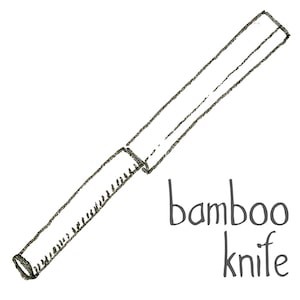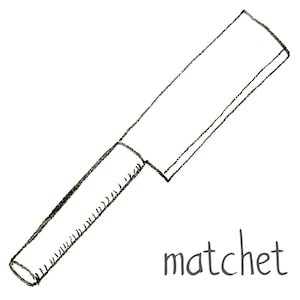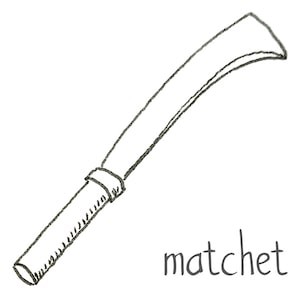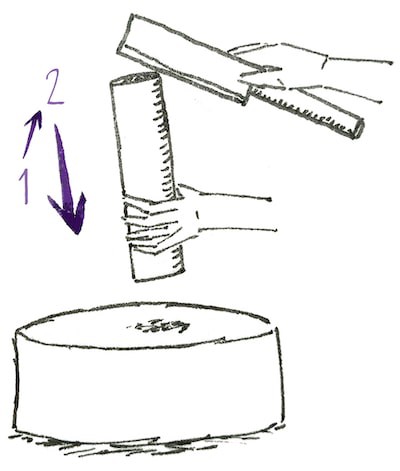How to split bamboo into flat slats?
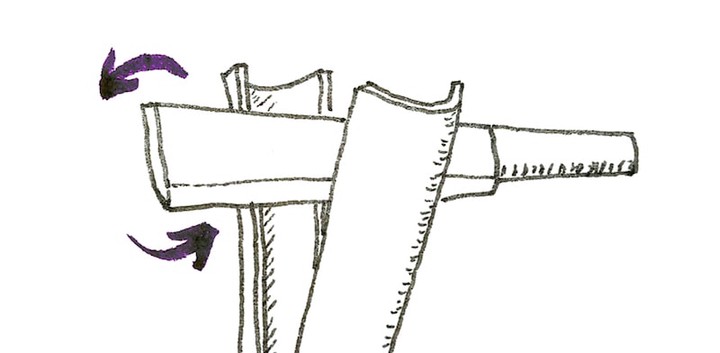
Which kind of tool can I use to split bamboo? How to immobilize the bamboo when splitting it? How to split? And how to obtain slats of the same width?
To answer these questions, I carefully reviewed the gestures of more than 18 highly skilled bamboo craftswomen and craftsmen from around the world! Then I summarized this review into a 8 min movie and this tutorial.
This tutorial is part of my bamboo craft project. This technique of splitting can be useful to make a trivet for hot pots or an underwear dryer.
Video review (8 min)
Wear gloves for safety!
It is always a good idea to wear gloves if you are a beginner, at least one glove for the more vulnerable hand which is holding the bamboo.
Which tool can I use to split bamboo?
To split a bamboo pole, we need to open a crack in the bamboo wall, using a blade, and then push the blade to separate the fibers.
This process is relatively easy because bamboo fibers easily detach from one another. After initiating the crack, we do not really cut the bamboo pole with the blade, we rather push apart the fibers thanks to the thickness of the blade.
Consequently, splitting bamboo only requires limited strength and simple and common manual tools. A mallet and matchet with a thick blade will suit most cases, although more appropriate tools can be chosen depending on the size of the pole, as we will see hereafter.
For small bamboo poles (< 20 cm long, < 8 in)
For medium bamboo poles (20 to 200 cm long, 8 to 78 in)
For medium bamboo poles, we can see a lot of options: a knife plus a mallet, or a matchet alone, or a specific tool called a bamboo splitter which can be used to cut strips of equal width with the help of a mallet or a hammer.
How to immobilize the bamboo when splitting?
For short bamboo poles (< 30 cm long, < 12 in)
For short bamboo and precise work, it is convenient to use a high and heavy wood support to work in the sitting position. It allows stability, safety, and precision.
A wood support also prevents from damaging the base of the bamboo itself, or the blade of the knife, as it is not always easy to control the blade perfectly and avoid it to hit the floor.
Sometimes, craftsmen and craftswomen don’t use any support. When they split bamboo sections that do not have nodes, or when their matchet is light, they can get enough control on the blade to avoid it hitting the floor. Or, when working outside, a grassy ground makes it safer for the blade.
For long bamboo poles (> 30 cm long, > 12 in)
For long bamboo poles, we can observe very different strategies.
Some people don’t use any support, and succeed in splitting the bamboo while holding it with one hand and cracking it with their matchet or axe in the other hand.
A more common way is to use the ground as a support, by opening a crack in the culms while it is maintained horizontally between the floor and one foot. To avoid damaging the bamboo or the blade, some craftsmen use a small wood support between the ground and the bamboo.

Or, it can also be more convenient to maintain the bamboo in an oblique position, between the ground and a sawhorse if we have access to it.

How to split?
In general, craftsmen split the bamboo culm from top to bottom. There are two main steps to split the bamboo:
- open a crack by inserting a blade into the bamboo, and
- separate the fibers by pushing and/or rotating the blade
For short and medium bamboo poles (< 300 cm long, < 120 in)
To split short and medium bamboo culms, hold the bamboo vertically with one hand, and with the other hand place the blade where you want to split, and open a crack by pushing the blade.
For small bamboos you can just hit the matchet or the knife with the hand directly.
For medium bamboos, you may need a mallet or you can raise  and hit
and hit  both the matchet and the bamboo against the ground.
both the matchet and the bamboo against the ground.
You can try what is the best for you depending on the kind of bamboo, your tools and your strength.
Then, separate the fibers by pushing the blade down. Again using your hand, a mallet, or by raising and hitting the bamboo against the ground. In general, it is quite easy between the nodes, where fibers are parallel to each other, but you will find more resistance when reaching the nodes.
With a bamboo splitter, the principle is the same: insert the blade to open a crack, then split by hitting with a mallet or a hammer, or by pushing with your hands.
After splitting your pole into halves, or in slats, you can split them again into even narrower slats, either by using the same technique, or by holding the slats in your hands if they are too flexible to stay straight.
A common trick: turning the wrist
A very common gesture that craftswomen and craftsmen do to separate the fibers is to rotate the wrist after opening a crack.
If the crack is deep enough, rotating the wrist can be more efficient than trying to push the blade tightly clamped in the bamboo pole, and less demanding than raising and hitting down both the matchet and the bamboo.
For very long bamboo poles (> 300 cm long, > 120 in)
For splitting very long bamboos the main difference is that we work horizontally instead of vertically.
Without a bamboo splitter, you can initiate an opening with a matchet or an axe, with or without a mallet. Then you can finish by pulling the slats apart, using your hands and a foot.

With a bamboo splitter, you also need to initiate the splitting using a matchet and a mallet. Then you can insert the bamboo pole in the splitter and push or pull it. It is easier to insert the bamboo culm when you opened at least one or two nodes with your matchet. Usually, several people work together on such long bamboo poles.

How to obtain slats of the same width?
Of course, with a bamboo splitter, it is easier to split equally wide slats. But what about if you don’t have a splitter, or if you want a different number of slats than what your splitter allows you to do?
A simple way to split slats of the same width is by visually positioning the knife carefully before hitting it. In order to keep an overview, craftsmen first open cracks for each slat, and only then do they finish the splitting for all the slats.
References used in the video
- Japan - NUPURI FILMS, 2016, Bamboo splitting and making strips for weaving
- Japan - Ocha & Co, 2016, How a Japanese Nara Takayama Bamboo Matcha Whisk or Chasen is made
- Taiwan - shengfenchien, 2009, bamboo chair (from 1 to 6)
- Myanmar - British Council Myanmar, 2015, From Craft to Art: Bamboo craft
- India - Doing Everything, 2020, Bamboo splitting process in a village of Tripura State for Agarbatti stick making
- Thailand - Sammi Law, 2011, Thai Home Business_Chopping Bamboo
- Unknown location - mlindsay527, 2011, Homemade Bamboo Splitter
- Bangladesh - Village BoyPro, 2018, Primitive Technology: Bamboo Cutting Techniques in Rural Village Bangladesh/Bamboo Cutting Ways
- India - Dsource Ekalpa India, 2011, Bamboo Crafts of Assam - Khaloi
- Colombia - Guadua Bamboo, 2013, Splitting Bamboo Poles
- Ethiopia - Institute of Nomadic Architecture, 2017, Amazing Woven Bamboo House
- Philippines (probably) - ryanpordables, 2015, How To Split A Bamboo Pole
- Unknown location - Andrew Eckhart, 2019, How to split Bamboo into 4 even pieces
- Laos - Anjali Madeira, 2013, Splitting bamboo in Laos
- Japan - Woodworking Enthusiasts, 2018, Ancient Technology of Making Bamboo Crafts - Most Incredible Bamboo Woodworking Ever
- Japan - Woodworking Enthusiasts, 2018, Ancient Technology of Making Beppu Bamboo Crafts - Incredible Bamboo Woodworking Skills
- Japan - Mista Matcha, 2017, How It’s Made - Bamboo Matcha Whisk (Chasen)
- Indonesia - R B, 2016, How to make a bamboo serving tray
- Hong Kong (probably) - CeliaLai304, 2016, Chinese Bamboo Basket
You can also find interesting complementary information about splitting bamboo at Guada Bamboo.
Did you enjoy this post?
Great! Then, you may also like to see how to saw bamboo and and how to drill bamboo.

